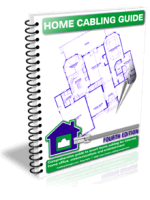| What Cabling Category to choose |
| A common question asked today is "What copper cabling to choose: Category 5, Enhanced Category 5 (Category 5E) or Category 6 ?". Please find below some guidelines that may help in answering this question. Category 5 cabling ****************** Advantages: - supports 10Base-T Ethernet and 100Base-T Fast Ethernet protocols - approved and established standard - supports 1000Base-T Gigabit Ethernet with additional testing according to TIA/EIA TSB-95 - very low cost (installation and components) Disadvantages: - limited or no support of future high-speed protocols - limited future-proofing - will be dropped from the new version of TIA/EIA-568 standard Recommended use: - very limited budget - 100Base-T Fast Ethernet is maximum requirement for today and future - no plans to support Gigabit Ethernet today or in future - short network life cycle (1-2 years) (for example, you plan to move to another building in 1 year) Enhanced Category 5 cabling *************************** Advantages: - supports 10Base-T Ethernet and 100Base-T Fast Ethernet protocols - approved standard (approved in November 1999) - supports 1000Base-T Gigabit Ethernet without additional testing Disadvantages: - limited or no support of future *very* high-speed protocols - costs up to 10-20% more compared to Category 5 cabling Recommended use: - today's recommended minimum - plans to support Gigabit Ethernet today or in future - no plans to support future high-speed protocols (like MultiGigabit Ethernet) - need in average network life cycle (about 5-7 years) without major upgrades Category 6 cabling ****************** Advantages: - supports 10Base-T Ethernet and 100Base-T Fast Ethernet protocols - supports 1000Base-T Gigabit Ethernet without additional testing - most future-proof UTP copper cabling available today Disadvantages: - not yet approved standard (approval is scheduled for 2000) (nevertheless, channel parameters are already stable, individual component parameters may subject to some change) - costs up to 30% more compared to Category 5 cabling - costs up to 15% more compared to Category 5E cabling - whole system must be bought from a single manufacturer with written Category 6 channel/component compliance warranty Recommended use: - plans to support 1000Base-T Gigabit Ethernet now or in future - plans to support future high-speed protocols (like MultiGigabit Ethernet) - need in long network life cycle (about 10+ years) without major upgrades General Recommendations *********************** 1) Category 5E is the *recommended* minimum. 2) The general principle is: the higher Category you choose, the larger will be the operational savings on cabling system upgrades (you will not need to upgrade the cabling system when upgrading active equipment). 3) Category 6 system should be bought from a single, reputable manufacturer (or cabling component manufacturer alliance) who gives written warranty on Category 6 channel/component compliance. |
| Back to Designer's Tips |

